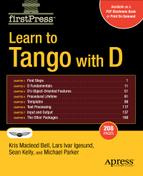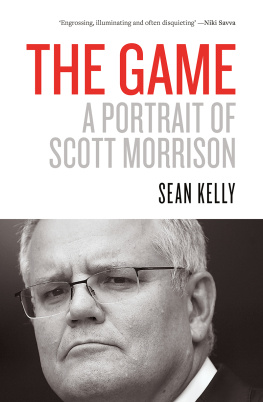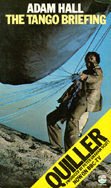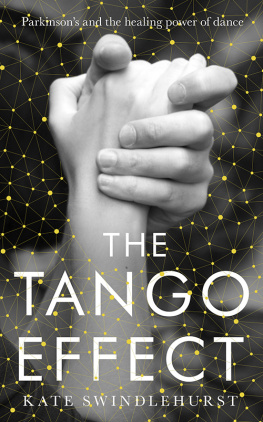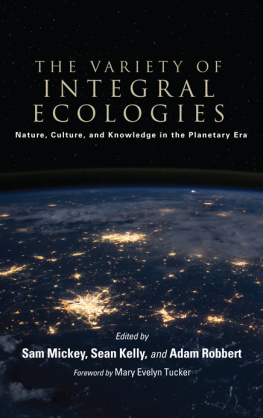Sean Kelly - Learn to Tango with D
Here you can read online Sean Kelly - Learn to Tango with D full text of the book (entire story) in english for free. Download pdf and epub, get meaning, cover and reviews about this ebook. year: 2018, publisher: Apress, genre: Home and family. Description of the work, (preface) as well as reviews are available. Best literature library LitArk.com created for fans of good reading and offers a wide selection of genres:
Romance novel
Science fiction
Adventure
Detective
Science
History
Home and family
Prose
Art
Politics
Computer
Non-fiction
Religion
Business
Children
Humor
Choose a favorite category and find really read worthwhile books. Enjoy immersion in the world of imagination, feel the emotions of the characters or learn something new for yourself, make an fascinating discovery.
- Book:Learn to Tango with D
- Author:
- Publisher:Apress
- Genre:
- Year:2018
- Rating:4 / 5
- Favourites:Add to favourites
- Your mark:
- 80
- 1
- 2
- 3
- 4
- 5
Learn to Tango with D: summary, description and annotation
We offer to read an annotation, description, summary or preface (depends on what the author of the book "Learn to Tango with D" wrote himself). If you haven't found the necessary information about the book — write in the comments, we will try to find it.
Learn to Tango with D — read online for free the complete book (whole text) full work
Below is the text of the book, divided by pages. System saving the place of the last page read, allows you to conveniently read the book "Learn to Tango with D" online for free, without having to search again every time where you left off. Put a bookmark, and you can go to the page where you finished reading at any time.
Font size:
Interval:
Bookmark:
Learn to Tango with D
Copyright 2007 by Kris Macleod Bell, Lars Ivar Igesund, Sean Kelly, Michael Parker
All rights reserved. No part of this work may be reproduced or transmitted in any form or by any means, electronic or mechanical, including photocopying, recording, or by any information storage or retrieval system, without the prior written permission of the copyright owner and the publisher.
ISBN-13 (pbk): 978-1-59059-960-0
ISBN-10 (pbk): 1-59059-960-8
eISBN-13: 978-1-4302-0585-2
Printed and bound in the United States of America (POD)
Trademarked names may appear in this book. Rather than use a trademark symbol with every occurrence of a trademarked name, we use the names only in an editorial fashion and to the benefit of the trademark owner, with no intention of infringement of the trademark.
Java and all Java-based marks are trademarks or registered trademarks of Sun Microsystems, Inc., in the United States and other countries. Apress, Inc., is not affiliated with Sun Microsystems, Inc., and this book was written without endorsement from Sun Microsystems, Inc.
Lead Editors: Jason Gilmore and Jeffrey Pepper
Technical Reviewers: Walter Bright and Don Clugston
Editorial Board: Steve Anglin, Ewan Buckingham, Tony Campbell, Gary Cornell, Jonathan Gennick, Jason Gilmore, Kevin Goff, Jonathan Hassell, Matthew Moodie, Joseph Ottinger, Jeffrey Pepper, Ben Renow-Clarke, Dominic Shakeshaft, Matt Wade, Tom Welsh
Project Manager: Beth Christmas
Copy Editor: Marilyn Smith
Associate Production Director: Kari Brooks-Copony
Compositor: Richard Ables
Cover Designer: Kurt Krames
Manufacturing Director: Tom Debolski
Distributed to the book trade worldwide by Springer-Verlag New York, Inc., 233 Spring Street, 6th Floor, New York, NY 10013. Phone 1-800-SPRINGER, fax 201-348-4505, e-mail , or visit http://www.springeronline.com.
For information on translations, please contact Apress directly at 2855 Telegraph Avenue, Suite 600, Berkeley, CA 94705. Phone 510-549-5930, fax 510-549-5939, e-mail , or visit http://www.apress.com.
The information in this book is distributed on an "as is" basis, without warranty. Although every precaution has been taken in the preparation of this work, neither the author(s) nor Apress shall have any liability to any person or entity with respect to any loss or damage caused or alleged to be caused directly or indirectly by the information contained in this work.
The source code for this book is available to readers at http://www.apress.com in the Source Code/Download section.
Application developers today can choose from a lot of programming languages, but by and large, most development falls into one of three groups of languages:
The C and C++ group, where close-to-the-metal, high performance is desired, and the programmer is willing to work hard to get it.
The Java and C# group, where code is compiled into a "managed" environment. The languages tend to be simpler, and vast libraries of prewritten code are usually available.
The dynamically typed scripting languages, dominated by Perl, Ruby, and Python. These languages offer rapid development but have poor runtime performance.
Several thousand computer programming languages are in existence, with perhaps a dozen that are in mainstream use. If someone created a new language, who would even look at it? It's not like we had any corporate backing, a marketing department, or a billion dollars to promote it.
So, inspired by the words of Gimli the dwarf, "Certainty of death, small chance of success... what are we waiting for?" we set out to invent and establish a new mainstream programming language.
What could have possessed us to do this? While one would think there's a nut for every programming language bolt out there, it turns out that there's a gaping hole. Amazingly, there is no language that enables precise control over execution while offering modern and proven constructs that improve productivity and reduce bugs. What first comes to mind is C++, but C++ remains mired in its need to be backward-compatible with obsolete, decades old decisions. This makes it very difficult for C++ to adopt new ideas. Then there are the languages that compile to virtual machines (VMs) such as Java and C#. But those languages never seem to quite be able to shake off their performance problems, and of course, a VM-based language cannot offer to-the-metal capability.
And lastly, there are the scripting languages such as Perl, Ruby, and Python. These offer many advanced programming features and are highly productive, but have poor runtime performance compared with C++. They also suffer from lingering doubts about their suitability for very large projects.
Often, programming teams will resort to a hybrid approach, where they will mix Python and C++, trying to get the productivity of Python and the performance of C++. The frequency of this approach indicates that there is a large unmet need in the programming language department.
D intends to fill that need. It combines the ability to do low-level manipulation of the machine with the latest technologies in building reliable, maintainable, portable, high-level code. D has moved well ahead of any other language in its abilities to support and integrate multiple paradigms like imperative, OOP, and generic programming.
So why us? How could we possibly succeed with no money, no backing, no paid staff, no marketing department-nothing one would expect to be required for such a monumental task? It turns out that a lot of these apparent disadvantages are actually advantages. The D team doesn't have anyone to answer to (other than the people who use D). We aren't saddled by investors who don't understand what we're doing but want quick monetary results. D doesn't have to fit somewhere in a corporate product line; it isn't positioned as a loss leader to move some other product. There's no marketing department to tell us we have to revamp D to match the latest buzzword du jour .
Since we're all volunteers, we are working on D because we genuinely want to and are enthusiastic about D. There aren't any clock-punchers or short-timers working on D.
And lastly, we are free to open source the language.
The D team has other crucial advantages. Many of us have decades of hard-core experience with C, C++, Java, and Perl, and are intimately familiar with what works and what doesn't work. We've worked on one-time throwaway programs and million-line monsters. We've worked on solo teams and professional corporate teams. Many of us are active in the programming community, teaching seminars and giving technology presentations.
D is a labor of love. This book is one of the fruits of that. The authors are all prominent members of the D team. I hope that, reading between the lines, you'll see the joy we take in the elegance with which D expresses the intent of the programmer.
We created D because D is the language we always wanted.
Walter Bright
KRIS BELL is a Scottish pirate and wannabe musician, part-time photographer, avid traveler, open source advocate, miscreant techie dweeb, and a principal Tango contributor. He enjoys swimming, cycling, sailing, and occasional hikes, and recently took up rock climbing. Previously, he dabbled in a bit of car racing and skydiving, and once took a flying-trapeze course (which served only to cement his vocation of choice). He currently lives in California, though he hails from the Scottish west coast and has a dodgy set of bagpipes to remind him of home.
Kris has a varied background in engineering and architecture, spanning application servers to RAD tool sets, embedded operating systems to graphics engines, workflow to high-performance clustering and failover substrata. Some commercial systems he has designed/built include enterprise and Internet application platforms, factory-automation systems, carrier-grade middleware, immersive-environment simulation, and crazy interactive clothing. In a different age, he would probably have been a steam-locomotive engineer, a swashbuckling Jolly Roger, or a funky bell-ringer.
Font size:
Interval:
Bookmark:
Similar books «Learn to Tango with D»
Look at similar books to Learn to Tango with D. We have selected literature similar in name and meaning in the hope of providing readers with more options to find new, interesting, not yet read works.
Discussion, reviews of the book Learn to Tango with D and just readers' own opinions. Leave your comments, write what you think about the work, its meaning or the main characters. Specify what exactly you liked and what you didn't like, and why you think so.

